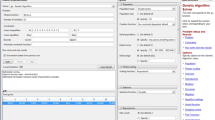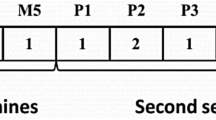Abstract
For each industrial, lean manufacturing is “The method” to improve productivity and reduce cost. One of the tools for lean is cellular manufacturing. This technique reduces the factory to several small entities which are easier to manage. The algorithm proposed in this paper is based on a simultaneous resolution of two interdependent problems. These two problems emerge when the flexibility is used during the production process. This paper proves the efficiency of the simultaneous resolution comparing to the sequential resolution with iterations. To compare only the resolution method, a unique grouping genetic algorithm is adapted to be used in both cases.




Similar content being viewed by others
Notes
PFA provides well-established, efficient and analytical engineering method for planning the change from process organization to product organization.
The complete case can available by email.
References
Adenso-Diaz, B., Lozano, S., Racero, J., & Guerrero, F. (2001). Machine cell formation in generalized group technology. Computers & Operations Research, 41(2), 227–240.
Akturk, M., & Turkcan, A. (2000). Cellular manufacturing system design using a holonistic approach. International Journal of Production Research, 38(1), 2327–2347.
Askin, R., Selim, H., & Vakharia, A. (1997). A methodology for designing flexible cellular manufacturing systems. IIE Transactions, 29(7), 599–610.
Baykasoglu, A., & Gindy, N. (2000). Mocacef 1.0: Multiple objective capability based approach to form part-machine groups for cellular manufacturing application. International Journal of Production Research, 38(5), 1133–1161.
Baykasoglu, A., Gindy, N., & Cobb, R. (2001). Capability based formulation and solution of multiple objective cell formation problems using simulated annealing. Integrated Manufacturing System, 12, 258–274.
Benjaafar, S., & Ramakrishnan, R. (1996). Measurement and evaluation of sequencing flexibility in manufacturing systems. International Journal of Production Research, 34, 1195–1220.
Caux, C., Bruniaux, R., & Pierreval, H. (2000). Cell formation with alternative process plans and machine capacity constraints: A new combined approach. International Journal of Production Economics, 64(1–3), 279–284.
Chandrasekharan, M., & Rajagopalan, R. (1986). An ideal seed non-hierarchical clustering algorithm for cellular manufacturing. International Journal of Production Research, 24(2), 451– 464.
Chen, J., & Heragu, S. (1999). Stepwise decomposition approaches for large scale cell formation problems. European Journal of Operational Research, 113, 64–79.
Choobineh, F. (1988). A framework for the design of cellular manufacturing systems. International Journal of Production Research, 26(7), 1161–1172.
Defersha, F., & Chen, M. (2006). A comprehensive mathematical model for the design of the cellular manufacturing systems. International Journal of Production Economics, 103, 767–783.
Diallo, M., Pierreval, H., & Quilliot, A. (2001). Manufacturing cells design with flexible routing capability in presence of unreliable machines. International Journal of Production Economics, 74(1), 175–182.
Falkenauer, E. (1998). Genetic algorithms for grouping problem. New York: Wiley.
Goncalves, J., & Resende, M. (2002). A hybrid genetic algorithm for manufacturing cell formation. Tech. rep., Rapport.
Gravel, M., Nsakanda, A., & Price, W. (1998). Efficient solutions to the cell-formation problem with multiple routings via a double-loop genetic algorithm. European Journal of Operational Research, 109, 286–298.
Gupta, T. (1993). Design of manufacturing cells for flexible environment considering alternative routeing. International Journal of Production Research, 31, 1259–1273.
Heragu, S., & Chen, J. (1998). Optimal solution of cellular manufacturing system design: Benders’ decomposition approach. European Journal of Operational Research, 107, 175–192.
Holland, J. (1975). Adaptation in natural and artificial systems. Ann Arbor, MI: The University of Michigan Press.
Hu, L., & Yasuda, K. (2006). Application of genetic algorithm for bin packing. International Journal of Production Research, 44(11) 1–35.
Hwang, H., & Ree, P. (1996). Routes selection for the cell formation problem with alternative part process plans. Computers & Operations Research, 30(3), 423–431.
Jayaswal, S., & Adil, G. (2004). An efficient algorithm for cell formation with sequence data, machine replications and alternative process routings. International Journal of Production Research, 42(12), 2419–2433.
Jeon, G., & Leep, H. (2006). Forming part families by using genetic algorithm and designing machine cells under demand changes. Computers & Operations Research, 33(1), 263–283.
Joines, J., Culbreth, C., & King, R. (1996a). Manufacturing cell design: An integer programming model employing genetic algorithms. IEE Transactions, 28, 69–85.
Joines, J., King, R., & Culbreth, C. (1996b). A comprehensive review of production-orien manufacturing cell formation techniques. International Journal of Factory Automation and Information Management, 3(3–4), 225–265.
Kang, S., & Wemmerlov, U. (1993a). A work load-oriented heuristic methodology for manufacturing cell formation allowing reallocation of operations. European Journal of Operational Research, 69, 292–311.
Kang, S., & Wemmerlov, U. (1993b). A work load-oriented heuristic methodology for manufacturing cell formation allowing reallocation of operations. European Journal of Operational Research, 69(3), 292–311.
Kazerooni, M., Luong, H., & Abhary, K. (1997). A genetic algorithm based cell design considering alternative routing. Computer-Integrated Manufacturing Systems, 10(2), 93–108.
Kima, Y., Park, K., & Ko, J. (2003). A symbiotic evolutionary algorithm for the integration of process planning and job shop scheduling. Computers & Operations Research, 30, 1151–1171.
Kusiak, A. (1987). The generalized group technology concept. International Journal of Production Research, 25, 561–569.
Kusiak, A., & Cho, M. (1992). Similarity coefficient algorithm for solving the group technology problem. International Journal of Production Research, 30(11), 2633–2646.
Lee, C., Lei, L., & Pinedo, M. (1997). Current trends in deterministic scheduling. Annals of Operations Research, 70, 1–41.
Lin, Y., & Solberg, J. (1991). Effectiveness of flexible routing control. The International Journal of Flexible Manufacturing Systems, 3, 189–211.
Logendran, R., Ramakrishna, P., & Srikandarajah, C. (1994). Tabu search-based heuristics for cellular manufacturing systems in the presence of alternative process plans. European Journal of Operational Research, 32(2), 273–297.
Lozano, S., Guerrero, F., Eguia, I., & Onieva, L. (1999). Cell design and loading in the presence of alternative routing. International Journal of Operational Research, 37(14), 3289–3304.
Mahdavi, I., Rezaeian, J., Shanker, K., & Amari, Z. (2006). A set partitioning based heuristic procedure for incremental cell formation with routing flexibility. International Journal of Production Research, 44(24), 5343–5361.
Mahesh, O., & Srinivasan, G. (2002). Incremental cell formation considering alternative machines. International Journal of Operational Research, 40(14), 3291–3310.
Mansouri, S., Moattar-Husseini, S., & Newman, S. (2000). A review of the modern approaches to multi-criteria cell design. International Journal of Production Research, 38(5), 1201–1218.
Mohamed, Z. (1996). A flexible approach to (re)configure flexible manufacturing cells. European Journal of Operational Research, 95, 566–576.
Moon, C., & Gen, M. (1999). A genetic algorithm-based approach for design of independent manufacturing cells. International Journal of Production Economics, 20(60–1), 421–426.
Mungwattana, A. (2000). Design of cellular manufacturing systems for dynamic and uncertain production requirements with presence of routing flexibility. Ph.D. thesis, Faculty of the Virginia Polytechnic Institute and State University.
Nagi, R., Harhalakis, G., & Proth, J. (1990). Multiple routings and capacity considerations in group technology applications. European Journal of Operational Research, 28(12), 2243–2257.
Nsakanda, A., Diaby, M., & Price, W. (2006). Hybrid genetic approach for solving large-scale capacitated cell formation problems with multiple routings. European Journal of Operational Research, 171(3), 1051–1070.
Rajamani, D., Singh, N., & Aneja, Y. (1992). Selection of parts and machines for cellularization: A mathematical programming approach. European Journal of Operational Research, 62(1), 47–54.
Ramabhatta, V., & Nagi, R. (1998). An integrated formulation of manufacturing cell formation with capacity planning and multiple routings. Annals of Operations Research, 77, 79–95.
Sankaran, S., & Kasilingam, G. (1990). An integrated approach to cell formation and part routing in group technology manufacturing systems. Engineering Optimization, 16, 235–245.
Sofianopoulou, S. (1999). Manufacturing cells design with alternative process plans and/or replicate machines. International Journal of Production Research, 37(3), 707–720.
Solimanpur, M., Vrat, P., & Shankar, R. (2004). A multi-objective genetic algorithm approach to the design of cellular manufacturing systems. International Journal of Production Research, 42(7), 1419–1441.
Stawowy, A. (2006). Evolutionary strategy for manufacturing cell design. OMEGA. The International Journal of Management Science, 34(1), 1–18.
Suresh, N., & Slomp, J. (2001). A multi-objective procedure for labor assignments and grouping in capacitated cell formation problems. International Journal of Production Research, 39(18), 4103–4131.
Uddin, M., & Shanker, K. (2002). Grouping of parts and machines in presence of alternative process routes by genetic algorithm. International Journal of Production Economics, 76(3), 219–228.
Vin, E. (2010). Genetic algorithms applied to generalized cell formation problem. Ph.D. thesis, Ecole Polytechnique de Bruxelles, Universit Libre de Bruxelles, Belgium.
Vin, E., DeLit, P., & Delchambre, A. (2003). Une approche intgre pour rsoudre le problme de formation des cellules de production avec des routages alternatifs. In MOSIM03 world symposium, April 23–25, 2003, France.
Vin, E., Francq, P., & Delchambre, A. (2006). A grouping genetic algorithm (simoggas) simultaneously to solve two grouping problems applied to the cell formation problem with alternative process plans. In Group technology/cellular manufacturing (GTCM06).
Vivekanand, P., & Narendran, T. (1998). Logical cell formation in fms, using flexibility-base criteria. International Journal of Flexible Manufacturing Systems, 10, 163–181.
Won, Y. (2000). New p-median approach to cell formation with alternative process plans. International Journal of Production Research, 38(1), 229–240.
Wu, T., Chen, J., & Yeh, J. (2004). A decomposition approach to the cell formation problem with alternative process plans. The International Journal of Advanced Manufacturing Technology, 24(11/12), 834–840.
Wu, T., Chung, S., & Chang, C. (2009). Hybrid simulated annealing algorithm with mutation operator to the cell formation problem with alternative process routing. Expert Systems with Applications, 36, 3652–3661.
Yin, Y., & Yasuda, K. (2002). Manufacturing cells’ design in consideration of various production factors. International Journal of Production Research, 40(4), 885–906.
Zhao, C., & Wu, Z. (2000). A genetic algorithm for manufacturing cell formation with multiple routes and multiple objectives. International Journal of Production Research, 38(2), 385–395.
Author information
Authors and Affiliations
Corresponding author
Rights and permissions
About this article
Cite this article
Vin, E., Delchambre, A. Generalized cell formation: iterative versus simultaneous resolution with grouping genetic algorithm. J Intell Manuf 25, 1113–1124 (2014). https://doi.org/10.1007/s10845-013-0749-7
Received:
Accepted:
Published:
Issue Date:
DOI: https://doi.org/10.1007/s10845-013-0749-7




